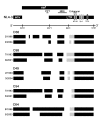Pathogenicity and immunogenicity of attenuated, nef-deleted HIV-1 strains in vivo
- PMID: 17888184
- PMCID: PMC2075523
- DOI: 10.1186/1742-4690-4-66
Pathogenicity and immunogenicity of attenuated, nef-deleted HIV-1 strains in vivo
Abstract
In efforts to develop an effective vaccine, sterilizing immunity to primate lentiviruses has only been achieved by the use of live attenuated viruses carrying major deletions in nef and other accessory genes. Although live attenuated HIV vaccines are unlikely to be developed due to a myriad of safety concerns, opportunities exist to better understand the correlates of immune protection against HIV infection by studying rare cohorts of long-term survivors infected with attenuated, nef-deleted HIV strains such as the Sydney blood bank cohort (SBBC). Here, we review studies of viral evolution, pathogenicity, and immune responses to HIV infection in SBBC members. The studies show that potent, broadly neutralizing anti-HIV antibodies and robust CD8+ T-cell responses to HIV infection were not necessary for long-term control of HIV infection in a subset of SBBC members, and were not sufficient to prevent HIV sequence evolution, augmentation of pathogenicity and eventual progression of HIV infection in another subset. However, a persistent T-helper proliferative response to HIV p24 antigen was associated with long-term control of infection. Together, these results underscore the importance of the host in the eventual outcome of infection. Thus, whilst generating an effective antibody and CD8+ T-cell response are an essential component of vaccines aimed at preventing primary HIV infection, T-helper responses may be important in the generation of an effective therapeutic vaccine aimed at blunting chronic HIV infection.
Figures



References
Publication types
MeSH terms
Substances
Grants and funding
LinkOut - more resources
Full Text Sources
Medical
Research Materials

